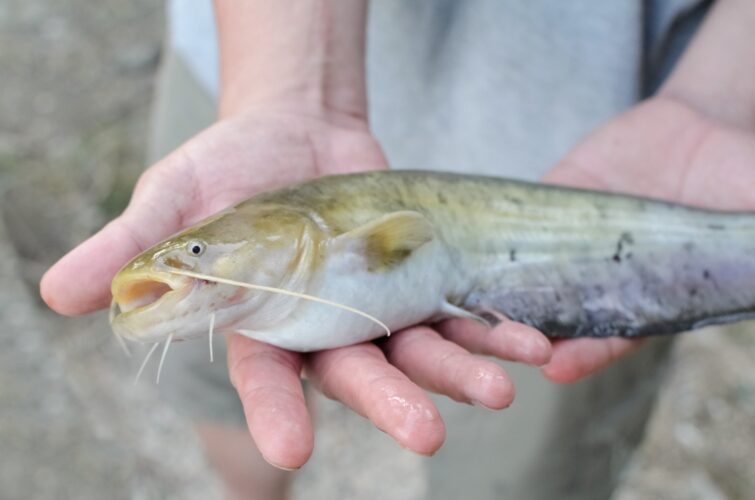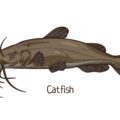Catfish and eels are two distinct types of fish that occupy different niches in aquatic ecosystems around the world. The term “catfish” refers to a diverse group of ray-finned fish known for their prominent barbels, which resemble a cat’s whiskers. These barbels house taste receptors which help catfish locate food in murky waters. In contrast, eels are elongated fish belonging to the order Anguilliformes, which includes both freshwater and marine species. Their snake-like bodies and lack of pelvic fins give them a distinctive appearance and swimming style compared to catfish.
Understanding the differences between catfish and eels involves examining their anatomies, habitats, and behaviors. Catfish generally have a more robust and flattened body, often with a strong, bony head shield, and are found in both freshwater and saltwater environments. They possess a varied diet, from smaller fish to detritus, reflecting their adaptability. Eels, however, typically have long and slender bodies with small, sharp teeth adapted for a diet of invertebrates and other fish. They tend to have a complex life cycle, with many eel species undertaking significant migrations for breeding.
While both catfish and eels have adapted to a wide range of environments, each has developed specific strategies for survival and reproduction. Catfish rely on their sense of taste, while eels’ bodies are suited to navigating through narrow crevices and burrowing into substrates. These adaptations underscore the remarkable diversity of the aquatic world and how various species have evolved to thrive in their respective ecological niches.

Biological Classification
In the domain of aquatic life, catfish and eels are distinguished by their different places in biological taxonomy, with specific differences in species diversity and classification within the framework of order and family.
Species Diversity
Catfish comprise a vast and diverse group of ray-finned fish known for their barbels, which resemble a cat’s whiskers. They belong to the order Siluriformes and have over 3,000 species spread across multiple families. In contrast, eels mostly fall under the order Anguilliformes, which includes about 800 species. Their elongated bodies and smooth skin set them apart from other fish species.
Order and Family
Both catfish and eels occupy distinct orders within the class of ray-finned fish (Actinopterygii). The diversity of catfish is organized into several families, with some of the most recognized being:
- Ictaluridae: North American freshwater catfish
- Ariidae: Sea catfishes
- Pimelodidae: Long-whiskered catfishes
Eels, primarily characterized by their snake-like bodies, belong predominantly to the order Anguilliformes and include families such as:
- Anguillidae: Freshwater eels
- Muraenidae: Moray eels
- Ophichthidae: Snake eels
Both groups have evolved to adapt to a variety of ecological niches, from freshwater habitats to deep marine environments.
Physical Characteristics
Catfish and eels exhibit distinguishable physical characteristics that make it easy to differentiate them. These differences span across body structure, size, weight, and skin coloration.
Body Shape and Structure
Catfish possess a more robust and rounded body, often accompanied by barbels, which resemble a cat’s whiskers, hence their name. They have rayed dorsal and pectoral fins, which are absent in eels. Eels are known for their elongated and slender bodies with a snake-like appearance. Most eel species, including the European eel, lack the definitive pelvic fins that catfish have.
Size and Weight
Variations are significant when comparing the size and weight of these two species. While catfish species can vary broadly in size, a typical adult catfish measures between 12-24 inches and can weigh up to 20 pounds. In contrast, the European eel can reach lengths of up to 39 inches and a weight that typically falls around 8-10 pounds. Electric eels, a type of knifefish often mistaken for true eels, can grow even longer, reaching up to 8 feet and weighing up to 44 pounds.
Skin and Coloration
Catfish skin is covered in a layer of mucus, which protects them from bacteria and parasites. They do not have scales, and their skin coloration can vary from species to species but often includes shades of brown to black. Eels, on the other hand, have a smooth and slimy skin that’s also scale-less. The European eel is known for its darker color, ranging from olive green to a brownish-black, with their belly being paler. The electric eel, while not a true eel, has a dark gray-brown color on top transitioning to a yellowish color underneath.
Habitat and Distribution
Catfish and eels exhibit distinct preferences in their habitats and distribution, occupying a range of water environments across the globe.
Water Environments
Catfish are typically found in freshwater environments such as lakes, rivers, and swamps. They thrive in still or slow-moving waters. In contrast, eels can be found in both freshwater and marine (oceanic) settings. Eels are known for living in mud or burrowing into the substrate both in freshwater and marine habitats.
Geographic Range
The geographic distribution of catfish is extensive, spanning across North America, Africa, and Asia. For example, the channel catfish, a well-known species, is native to North America, particularly prevalent in the Mississippi River basin. On the other hand, eels can be found across many of the world’s oceans, with freshwater types frequenting rivers and estuaries before migrating to the ocean to breed.
Preferred Habitats
Catfish often prefer shallow waters where they can easily scavenge or hunt for food. They are excellently adapted to muddy or swampy conditions, where they use barbels to locate their meals. Eels generally favor shallow marine areas or estuaries during the growth phase and deep oceanic waters during the breeding phase. Some species even adapt to wholly freshwater life cycles, but these tend to be exceptions rather than the norm.
Diet and Predation
Catfish and eels possess distinct dietary habits and face different challenges and interactions with predators in their respective aquatic environments.
Feeding Habits
Catfish are typically omnivorous, feeding on a wide range of organisms, which include fish, crustaceans, and plant material. They use their barbels to search for food on the riverbed. Eels, specifically those of the family Anguillidae, are primarily carnivorous and consume other fish and invertebrates. Their diet consists mainly of protein-rich foods.
- Catfish: Omni-directional feeders; consume plant material and animals.
- Eels: Predominantly carnivorous; focus on animal matter.
Common Prey and Predators
Catfish and eels target different prey species based on their feeding habits:
- Catfish Prey: Smaller fish, invertebrates such as worms and crustaceans including crayfish, crabs, and shrimp.
- Eel Prey: Mainly smaller fish and a variety of invertebrates.
Predators of these species vary with size and habitat. Large fish and birds of prey are common threats.
- Catfish Predators: Birds of prey, larger fish, and humans.
- Eel Predators: Larger fish, marine mammals when at sea, and humans.
It should be noted that the specific diet and predators can vary significantly depending on the species of catfish or eel and the particular ecosystem in which they reside.
Reproductive Behavior
The reproductive cycles of catfish and eel are characterized by distinct life stages and spawning habits, which are crucial for the continuation of their respective species.
Life Cycle
Both catfish and eels have complex life cycles that begin with the spawning of eggs and end at the adult stage. Catfish typically have a simpler life cycle, where the eggs hatch into larvae and then develop into juveniles before reaching adulthood. Eels, on the other hand, exhibit a more unique life cycle. After hatching, eel larvae—known as leptocephali—drift in ocean currents for an extended period before transforming into elvers, a transitional stage. These elvers then migrate to freshwater or brackish environments where they mature into adults.
- Catfish
- Eggs ➔ Larvae ➔ Juveniles ➔ Adults
- Eels
- Eggs ➔ Leptocephali ➔ Elvers ➔ Adults
Spawning and Development
Catfish spawn primarily in inland water sources such as rivers and lakes, often during the spring or summer months. They typically deposit their eggs in nests or hidden environments conducive to the safety and development of the offspring. The eggs hatch in a matter of days to weeks, depending on the species and environmental conditions.
Eels, specifically the European and American eels, undertake significant migrations for reproduction, traveling from their freshwater adult habitats back to specific oceanic regions, such as the Sargasso Sea, to spawn. The exact spawning process remains somewhat mysterious, but it is believed that after spawning, adult eels die. This remarkable migration and subsequent spawn are essential for maintaining the eel population.
- Catfish
- Spawning: Inland waters in spring/summer
- Development: Quick hatching in safe environments
- Eels
- Spawning: Long migrations to oceanic regions
- Development: Extensive larval drift before reaching juvenile habitats
Ecological Role and Impact
Catfish and eels play distinct roles in aquatic ecosystems and have varying impacts on human activities. These differences are shaped by their behavioral patterns, feeding habits, and their position in the food chain.
In Ecosystem
Catfish are predominantly bottom feeders and often play the role of scavengers, helping to clean up dead organisms and detritus in their habitats. Their barbels, or whisker-like structures, equip them to detect food in murky environments. As nocturnal predators, they also control populations of smaller fish and invertebrates.
Freshwater eels, including the well-known freshwater eels, exhibit a life cycle that contributes to both marine and freshwater ecosystems. They typically breed in the ocean and spend their adult lives in freshwater or brackish environments. Eels, like catfish, are predators and consume a variety of prey, but they tend to have a more varied diet that can range from other fish to crustaceans.
Garden eels, a subgroup of eels, are a notable exception. These creatures live in colonies and are rarely seen outside their burrows, feeding on plankton brought by currents. Their presence indicates healthy reef ecosystems.
On Human Activities
Catfishing has long been a part of human recreation and sustenance, with some species of catfish being cultivated for food. In addition, catfish have been used by anglers as a sport fish, and their ability to adapt to different environments makes them stable for aquaculture.
Eels, on the other hand, have historically been a delicacy in many cultures. Overfishing to meet the demand for eel consumption poses significant threats to their populations. Moreover, the migration patterns of eels are crucial for their life cycle, and disruptions caused by human-made structures can impact their numbers.
Both catfish and eels may also be indicators of environmental health. A decline in their populations could signal potential threats to ecosystems, such as pollution or habitat destruction.
Nutritional Profile
When understanding the nutrition of catfish and eel, it is important to consider their distinct profiles in terms of macronutrients, such as protein and fats, and micronutrients, including a range of vitamins and minerals.
Macronutrients and Micronutrients
Catfish and eel offer significant nutritional value through various macronutrients and micronutrients. Both are excellent sources of protein, essential for muscle repair and growth. Their fat content varies, with catfish generally containing less fat compared to eel, which often has a higher amount of monounsaturated fats. Catfish and eel differ in their mineral content but both hold appreciable amounts of phosphorus and selenium.
- Protein: Essential for tissue repair and enzymatic activities.
- Fats: Source of energy; includes saturated and mono-unsaturated fats.
- Calories: Energy value of the food; influenced by protein, fat, and carbohydrates content.
- Cholesterol: A waxy substance found in the blood, influenced by dietary intake.
Vitamins and Minerals
Catfish and eel possess an array of vitamins and minerals that are crucial for overall health. Vitamin B12 is especially rich in eel, supporting blood and nerve health, while catfish are well known for their Vitamin B3 content, aiding in energy metabolism. Both fish provide a good source of Vitamin D although eel tends to have a higher concentration.
- Vitamins: Vital for immune function, energy production, and bone health.
- Minerals: Important for bone structure, neural communication, and fluid balance.
The table below showcases the differences in vitamin and mineral content:
| Nutrient | Catfish (per 100g) | Eel (per 100g) |
|---|---|---|
| Vitamin A RAE | 40µg | 60µg |
| Vitamin C | 0.7mg | 0mg |
| Vitamin B1 | 0.04mg | 0.225mg |
| Vitamin B2 | 0.065mg | 0.18mg |
| Vitamin B3 | 2.84mg | 1.60mg |
| Vitamin B5 | 0.925mg | 1.1mg |
| Vitamin B6 | 0.041mg | 0.160mg |
| Vitamin B12 | 1.53µg | 20µg |
| Vitamin K | 0.1µg | – |
| Zinc | 0.5mg | 1.0mg |
| Copper | 0.1mg | 0.228mg |
| Selenium | 13.9µg | – |
| Calcium | 17mg | – |
| Magnesium | 23mg | – |
| Phosphorus | 200mg | 210mg |
| Potassium | 366mg | – |
| Sodium | 42mg | 55mg |
| Manganese | – | – |
It should be noted that the exact values can vary based on the species, diet, and environment of the fish. Nutrition profiles may also differ by preparation and cooking methods.
Fishing and Aquaculture
Fishing practices for catfish and eel differ significantly due to their habitats and behaviors. Aquaculture of these species also presents distinct challenges and methods.
Commercial Fishing
Commercial fishing of catfish predominantly involves the use of nets and traps since catfish are bottom-dwellers and are attracted to live bait. In contrast, eel fishing commercially often employs longlines and fyke nets due to eels’ preference for hiding within the substrate of their aquatic environments. Eels’ poor vision but strong sense of smell aids them in finding food, thus bait used in eel fishing is designed to emit strong scents.
- Catfish: Primarily net and trap fishing, with catfish farms raising them in ponds or tanks.
- Eel: Uses longlines, fyke nets, and eel-specific traps. Eel farms typically require complex rearing systems.
Recreational Fishing
Recreational anglers targeting catfish might use rods and reels with heavy-duty lines to combat catfish strength. Eels, being more slippery and agile, challenge fishermen who often need to adopt specialized techniques like nighttime fishing, when eels are more active.
- Catfish: Anglers favor rods, reels, and live bait; frequent in freshwater lakes and rivers.
- Eel: Anglers prefer nighttime, utilizing spearing or baiting methods; common in coastal and estuarine waters.
Conservation Efforts
The catfish and eel populations face threats from overfishing and habitat degradation. Conservation efforts include regulated fishing seasons, size and catch limits, and restrictions on gear types.
- Catfish: Efforts focus on habitat restoration, such as constructing fish passages around dams that limit access to spawning areas.
- Eel: International regulations control eel fishing to combat declining populations, with significant research dedicated to understanding their complex life cycle.
Both species are subject to predation pressures; hence, managing their populations in the wild through sustainably balanced fishing practices is critical. Aquaculture provides a controlled alternative that alleviates some of the fishing pressure on wild stocks.

Cultural Significance
Catfish and eel hold distinct places in various cultures, primarily through their roles in culinary traditions and their symbolic meanings in mythology. Their impact varies across different regions, such as Africa and Asia, reflecting the local diet and cultural narratives.
Culinary Traditions
Catfish has a firm place in the diets of many cultures around the world, notably in African and Asian cuisines. It is valued as a significant source of protein and is often enjoyed grilled, fried, or stewed.
- In African countries such as Nigeria, catfish is used in traditional dishes like Pepper Soup.
- In parts of Asia, catfish is a common ingredient in recipes like the Vietnamese Cá Kho Tộ (caramelized fish in a clay pot).
Eel, on the other hand, is a specialty food in countries such as Japan, where the protein-rich meat is considered a delicacy. Eels are typically prepared as kabayaki, where they are grilled and glazed with a sweet soy-based sauce.
- Dining on eel during the summer season is a cultural tradition in Japan, linked to health and stamina.











